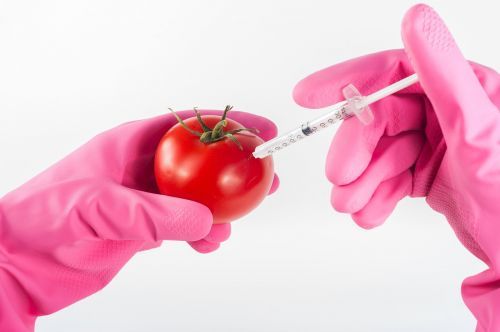Credits
Harvard University Science in the news, Why Roundup Ready Crops Have Lost their Allure by Jordan Wilkerson (August 10th 2015) [Online] Available from: http://sitn.hms.harvard.edu/flash/2015/roundup-ready-crops/ [Accessed 23/11/20]
Nature Biotechnology, Improving the nutritional value of Golden Rice through increased pro-vitamin A content, by Jacqueline A Paine, Catherine A Shipton, Sunandha Chaggar, Rhian M Howells, Mike J Kennedy, Gareth Vernon, Susan Y Wright, Edward Hinchliffe, Jessica L Adams, Aron L Silverstone & Rachel Drake (April 1st 2005) [Online] Available from: https://www.nature.com/articles/nbt1082 [Accessed 23/11/20]
Scientific American, (September 2013) by David H. Freedman The Truth about Genetically Modified Food [Online] Available from: https://www.scientificamerican.com/article/the-truth-about-genetically-modified-food/ [Accessed on 23/11/20]
What are GM Foods?
GM refers to any living thing that’s had its DNA altered using genetic engineering. This could be a plant, animal (including humans) or bacterium and the modification is typically done to introduce a desirable trait into the organism, such as drought resistance, or bearing larger fruit.
To some extent, humans have been involved in genetic modification for centuries. For example, larger cattle which gave more milk were bred to produce even larger offspring. Seeds from cereals and other crops that were hardier and grew better were selected for planting the following year to produce better yields. With genetically modified organisms however, the modifications involved are often of a kind that could not possibly occur naturally. For example, adding cow growth hormone to the embryo of a broiler chicken to produce a larger, faster growing chicken, or adding genes from a virus to a plant to allow it to become resistant to the virus.

What are Some Benefits to Genetically Modifying Foods?
There are many reasons why GM foods could be advantageous. For example, a crop could be made to grow more quickly, with increased protein and vitamin levels, or with less fat. An often-used argument in favour of GM crops is that drought-resistant crops could help to alleviate famine in developing countries, where low rainfall often leads to food shortages. Techniques have also been developed to make fresh produce last longer, so that it can ripen on the plant and be transported more easily with less wastage.
The Golden Rice Project is an example of food being modified to increase the nutrients it contains. In this example, rice was engineered to contain more vitamin A and was planted in areas such as the Philippines and Bangladesh, where vitamin A deficiency is a cause of child blindness and mortality.
The first GM food products - a tomato puree and a vegetarian cheese - appeared in British supermarkets in 1996. The puree was made from tomatoes which were designed to stay firmer for longer, leading to less waste in harvesting. The tomatoes also held less water, meaning that less water was required to grow them and less energy was used removing water from them to turn them into puree. This in turn made the puree cheaper for the consumer.
The first GM soya was planted in the US in the same year, and by 2015, more than 93% of corn and soy grown in the US was genetically modified. Between 60% and 70% of all processed foods on supermarket shelves could now contain some GM soya. Monsanto, the world's major GM manufacturer has developed a strain of GM soya which is resistant to Roundup, its own brand of herbicide. This allows weeds to be controlled even after the soya has started to grow, saving an estimated 33% on the amount of herbicide used. Roundup Ready soya amounted to 15% of the 1997 US soya crop, but the patent for these soybeans expired in 2014. In 2016, Monsanto introduced Roundup Ready Xtend soybeans, modified to tolerate two different pesticides, dicamba and glyphosate. Xtend soybeans were planted on 1 million acres in 2016, and by 2020 were projected to be planted on 50 million acres.
GM foods have been largely accepted by the Americans, with many of them saying that they would buy GM foods even if they were simply engineered to stay fresh for longer. Even more would purchase foods modified to resist insect pests, resulting in less use of pesticides.

Photo: Orin Hargraves
What are Some of the Arguments Against GM Foods?

In the UK, we are being far more cautious about GM foods, possibly with good reason. Lessons learned during the BSE crisis are still very much in people's minds. Can we trust what we are eating, and what could be the long-term effects?
We have potentially more to lose from the introduction of GM crops. In America, farming takes place on an industrial scale, with millions of acres used exclusively for growing crops. Intensive use of pesticides has virtually wiped out wild animals and plants in the huge crop fields of the US. These farms are separate to the rest of the countryside and large national parks and nature reserves. Here however, farms are an integral part of the countryside. The use of herbicide- or insect-resistant crops could potentially have severe effects on our biodiversity, by virtually wiping out wild flowers and consequently the insects that feed on them, and further up the food chain, the predators that eat the insects.
Some crops are being developed to improve soil quality, by removing heavy metals from the soil, for example, so that they can be harvested and destroyed. An excellent idea, but what about the animals that eat the contaminated plants? Others are being developed for salt resistance, so that they can be grown in previously unusable areas. But what if their seeds were to be carried to a saltmarsh? Would they be a threat to wild species that have lived there naturally for years?
Plants are also adapted to survive. As a result of the Roundup Ready soybeans, weeds started to develop resistance to glyphosate weed killer. Since then, twenty-four cases of glyphosate-resistant weeds have been reported around the world, 14 of which are in the United States.
So far, there is no evidence of GM food being harmful to humans, but the rules governing their testing are less strict than with medicines, and after BSE, we know that "no scientific evidence of harm" is not the same as "safe to eat". Bovine spongiform encephalopathy (BSE), commonly known as mad cow disease, is a neurodegenerative disease of cattle. In 1996, it was discovered that the disease could cross over to humans via the consumption of beef products from infected cows. This caused Variant Creutzfeldt–Jakob disease, a fatal brain disease. As of 2012, 170 people had died of vCJD.
A report published by Dr Arpad Pusztai in 1998 sparked off public fears about GM foods. He claimed that his experiments, which involved feeding rats with potatoes genetically modified with a lectin gene from a snowdrop, caused stunted growth and immune system problems for the rats. His report was been heavily criticised by other scientists, and he was suspended from The Rowett Institute, where he had conducted his research. The Royal Society of Medicine declared that the study was ‘flawed in many aspects of design, execution and analysis’ and that ‘no conclusions should be drawn from it’. However, in 2005, he received the Whistleblower Award of the Federation of German Scientists for his study and In 2009, Pusztai and his wife, Prof. Bardócz Zsuzsa, received the Stuttgart Peace Prize.
Laboratory tests have shown that pollen from GM maize in the US damaged the caterpillars of the Monarch butterfly. This is a case of damage to a single species, but it does show that genetically-modified organisms could have the potential to do unexpected harm to other plants and animals. In the end, this could lead to a loss of biodiversity and to certain animal and wild plant species effectively being rendered extinct.
Where test crops have been planted in this country, there is a definite danger of cross-contamination with wild or non-GM plant strains. Even with very strict controls in place, it is impossible to prevent pollen from travelling on the wind from GM crops to other, possibly organic versions of the same crop being grown nearby. Pollen could also be carried by insects. This could mean that in the end, all our food crops could contain a proportion of genetically-modified elements, and we as consumers would lose our right to choose whether to eat GM foods or not.
Who profits from GM Food?
Whatever the potential gains for humanity, GM crops are being developed for profit. There may well be huge benefits to be had, but huge sums of money - currently billions of dollars - would not be invested in gene research if there were not the possibility of massive financial gains for the producers of GM crop strains in the future. Many strains of crop developed by biotech companies have a 'terminator' gene built in to them to prevent farmers from keeping seeds produced by their crops for the following year. This has lead to complete dependence on the biotech company year on year, a very worrying development for farmers in poorer countries. Even when farmers don’t grow their own GM crops, seeds can blow in from neighbouring fields, making it necessary to buy an expensive license for them or risk being fined.
The countries most affected by drought and famine, which are purported to be potentially the greatest beneficiaries of GM foods, have not always shown great enthusiasm for the newly developed crops. In fact, in 1998, 20 African countries including Ethiopia published a statement in which they stated that gene technologies would not help their farmers, but would 'destroy the diversity, the local knowledge and the sustainable agricultural systems.... and undermine our capacity to feed ourselves'.
Almost all anti-GM studies to date have been discredited or retracted as a result of using having been shown to have used unscientific research methods. However some critics maintain that anti GM scientists are afraid of publishing negative findings in case they are granted less funding for their studies as a result.
It is likely the politics of GM foods will continue to be debated for some time. Meanwhile, independent projects such as The Genetic Literacy Project ( link to https://geneticliteracyproject.org) exist in order to help consumers make informed decisions about their food choices.




